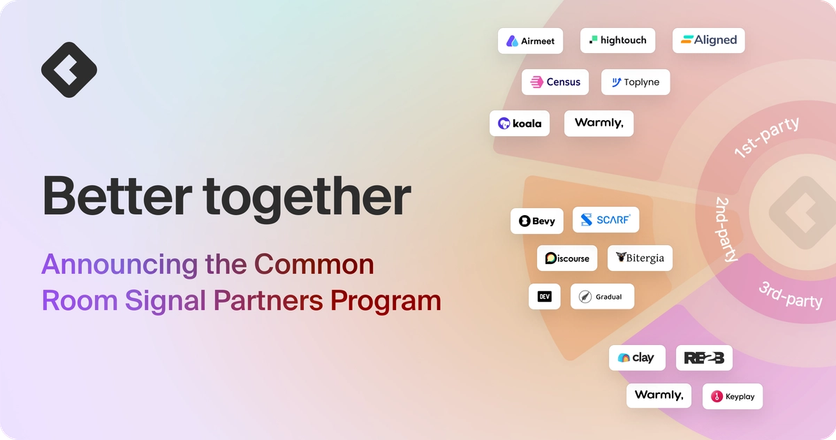12 min read
To delight developers and keep your product or project as a mission-critical part of their tech stack, you must deliver a great developer experience (DX).
A delightful DX begins when a developer discovers your solution and starts using it, but that’s only the beginning. Considering developers' preferences and continuing to benchmark and invest in DX will guarantee developers continue to use your offering rather than seeking a competitor who might better accommodate their preferences.
Why measuring developer experience is mission-critical
The quality of your DX will determine how developers feel about your offering, and whether they'll continue to use your product or look to a competitor instead.
If your product is invested in making these actions as easy as possible, the returns on that effort will grow the longer a developer uses your solution. In other words, if you have a strong offering with a great DX, developers and their teams will have no reason to seek out a new solution.
To ensure your solution is meeting developers’ needs, you have to properly quantify and measure the developer experience. After all, feedback is an essential part of continually improving your product and staying ahead of the competition. And the best, data-backed way to measure the experience is by leveraging metrics and key performance indicators (KPIs).
Developer experience metrics and KPIs
Developer experience metrics and KPIs are useful when evaluating the quality and effectiveness of the DX you’re providing. They help you assess the efficiency, productivity, and satisfaction of developers, which can directly impact product development and engineering team performance.
Here are some key developer experience metrics and KPIs:
Onboarding time
This metric refers to the time required for a developer to integrate your product into their workflows. A shorter onboarding time signifies the effectiveness of the onboarding process and the clarity of the documentation provided. It implies the developer can quickly utilize your product, resulting in a reduced time to achieve value from it.
Lead time
This metric measures the duration from idea to production, indicating how quickly new features are developed and deployed. Shorter lead times drive faster time to market and demonstrate greater responsiveness to customer needs, which can improve customer satisfaction.
Usability
This metric assess how user-friendly developers find your software. Improved usability increases developer efficiency, reduces errors, and accelerates their development cycles.
Findability
This metric measures how easily developers can locate code, documentation, and resources. With improved findability, developers spend less time searching for information, enabling faster development cycles and better collaboration.
Developer velocity
This metric quantifies the productivity and output that developers or teams are able to achieve by using your solution. Higher velocity translates to faster feature delivery and shorter time to market.
Credibility
This metric evaluates the trustworthiness of development practices, security measures, and adherence to industry standards. Improving credibility enhances the quality and security of software solutions, boosting customer satisfaction and trust while reducing risks and disruptions to development teams.
How to start measuring developer experience
Here are three steps you can take to start implementing a DX measurement infrastructure in your company:
- Identify key metrics: Begin by identifying the key metrics that align with your goals for measuring developer experience. Choose metrics that will help you assess the efficiency, productivity, and satisfaction of your developers.
- Establish a baseline: Before making any changes, establish a baseline measurement for the identified metrics. This will serve as a starting point for comparison and help you track progress over time. Collect data through surveys, interviews, and existing systems to gather insights on the current state of developer experience.
- Implement measurement mechanisms: Tracking tools automate the data collection process, ensuring accuracy and consistency in the measurements. Their analysis capabilities enable you to derive insights from the collected data so you can identify areas for improvement and optimize the developer experience.
Best practices for measuring and improving DX
With all of these things considered, delivering a great developer experience is now table stakes for software providers who build solutions for developers. This section will provide best practices to deliver a world-class DX:
- Understand the developer journey
- Provide great documentation and resources
- Cultivate a user community
- Automate
Understand the developer journey
Like any user, developers desire an easy onboarding experience, clear resources, helpful automations, and the ability to self-serve.
To deliver this, you must first understand your developer, including their skillset, role, and motivations. What needs and knowledge do they bring when first interacting with your product or project? How does that impact their initial onboarding? From setting up developer machinery to delivering code to production, understanding where tasks become tedious for developers will help you deliver a better DX.
Start by thinking of DX like UX (user experience) and consider the cognitive load your product demands. For example, do you know how long it takes to complete an action or how many context switches are involved?
A proper grasp of the developer's journey with your framework, language, or platform is paramount to all best practices. Only then can you identify points of friction developers may experience with your product and remove them proactively.
Provide great documentation and resources
Great documentation is an excellent way to guarantee developers continue to use your solutions for their own projects and products. If your tool offers excellent features but lacks easy-to-use documentation, the developer experience will be subpar and could mean users look for another solution.
Strong documentation helps developers understand how to use your offering. It should include detailed explanations of the various features and capabilities of your product, along with examples of how to use those features. These details will help developers learn how to use your solution more quickly and effectively so they can take full advantage of its capabilities.
Documentation can also help reduce the amount of time developers spend searching for answers to their questions. If documentation is thorough and well-organized, developers can easily find the information they need, which can help to improve their productivity and reduce the amount of time they spend trying to figure things out on their own.
Cultivate a user community
Building a user community around your project or product is another critical way developers can get (and share) best practices for using your solution.
User communities are groups of people who use a particular platform, tool, or framework, and get together to share their experiences and knowledge with one another on channels like Discord, Reddit, Stack Overflow, GitHub, and more.
They can be a valuable resource for developers, as communities give them the ability to ask questions and get answers from others who have experience with the product or project—as well as your team if you’re engaged in the community. Involvement in a user community also helps developers stay up to date on the latest launches, features, resources, and best practices around an offering.
Automate
Automation plays a crucial role in measuring developer experience by streamlining data collection, metrics calculations, and reporting processes.
Data collection
Automation tools can collect data from multiple sources, including code repositories, issue-tracking systems, and deployment pipelines. This eliminates the need for manual data collection, saving time and ensuring consistent and reliable data.
Metrics calculation
Automation simplifies the calculation of metrics by automatically processing the collected data and generating accurate analysis. This reduces human error and provides real-time insights into the developer experience.
Reporting and visualization
Automated solutions generate comprehensive reports and easy-to-read visualizations of DX metrics. Sharing these reports with stakeholders enables data-driven decision-making and facilitates communication about DX improvements.
Some benefits of automation when it comes to DX measurement include:
- Efficiency: By reducing manual effort when it comes to data collection and analysis, teams can focus on their core responsibilities.
- Accuracy and reliability: Automated processes reduce the risk of human error, ensuring more consistent and accurate data collection, as well as reliable calculation and reporting.
- Real-time insights: Automation allows for real-time data collection and analysis of DX, enabling prompt actions and improvements.
Automation is no longer a nice-to-have, but a must-have. Organizations that fail to automate risk:
- Inconsistent data: Relying on manual data collection rather than automation can lead to inconsistencies and errors, affecting the accuracy and reliability of DX metrics.
- Time-intensive processes: Manual data collection and calculation processes are time-intensive, disrupting developers’ core responsibilities and delaying the availability of insights.
- Limited scalability: As an organization grows and the developer environment becomes more complex, it’ll become increasingly harder to scale manual processes, hindering the ability to effectively measure DX.
Let's consider an example using an imaginary software company called ACME.io.
It decides to automate the measurement of onboarding time as a DX metric. ACME.io's automated onboarding system tracks tasks like setting up development environments and accessing code repositories, recording the duration of each task. This eliminates manual time tracking and provides real-time onboarding time metrics.
Automation provides ACME.io with accurate insights into the efficiency of their onboarding process. If the system shows excessive time spent on environment setup, the company can develop ways to streamline the process.
Also, automation allows consistent and reliable measurement, enabling data-driven decisions and continuous improvement of the onboarding experience. As a result, ACME.io now optimizes its setup process to reduce onboarding time, enhance DX, and improve productivity.
What impacts a great developer experience?
In addition to the tactical best practices described above, a great developer experience is also enabled by a team or company’s investment in three core principles: culture, community, and communication.
Culture
Prioritizing a great developer experience should be a core tenant of your company’s culture. Strive to create a culture that prioritizes and is responsive to developers' needs, with resources readily available to offer support in a timely fashion.
This culture often comes from the top, so be sure that your company's leadership is committed to this goal and understands its value. Once you have executive buy-in, be clear with everyone at the organization about their role in delivering a great DX.
When your company is living a culture that prioritizes DX, developers will feel it in their interactions with your people and products—often through interactions across your community channels.
Community
In addition to the tactical elements of community discussed above—what channels you’re using, response-time SLAs, champions programs, etc.—be sure you have an overarching community goal tied to developer experience.
Community represents the sum total of all the interactions you’re having with members across digital and in-person channels. It's how developers will experience the DX-first culture you’ve developed.
Developers need somewhere to go when they've hit a roadblock or want to share something cool they learned or created. And they need to know that whatever they’re sharing will get a positive and timely response. Good user communities can help cultivate strong DX because they provide the platform and framework for communication, collaboration, innovation, and problem-solving.
As an intelligent community growth platform, Common Room automatically gathers and analyzes community data, quantifying and tracking the effectiveness of your community initiatives. The platform also measures engagement and sentiment, which provides insights into whether developers are having a positive experience with your solution.
Communication
Growing a community and ensuring developers experience the culture you’ve created requires communication. Implementing this principle breathes life into the first two.
Your community members are not your audience; you’re talking with them, not to them. Be open, welcoming, and transparent in how you’re interacting and you’ll see greater engagement and better feedback.
With Common Room, you can measure responsiveness to assess whether members are receiving timely responses to their thoughts, questions, or concerns. Doing so allows you to stay on top of conversations and take actions that ensure community members continue to participate.
The role of community in DX
Building a community provides the best environment for developers to learn more about your product or project. It helps you stay responsive to devs' needs and gives them access to other community members. This way, they can solve problems quickly and learn from each other at the same time.
Platforms like Slack and Discord make connecting with developers using your product easy. These platforms can help you generate product feedback so you can make improvements for your community members. For example, taking the most common pain points your community members express and turning them into better documentation.
Building a community is really about building and growing human relationships. A community will help you identify your most impactful community members and more deeply engage with them to drive your product and business forward.
How Common Room helps you benchmark a better developer experience
Common Room can help you engage and grow your community. If you're ready to put DX best practices to use, it's time to get to know your users better.
Common Room's platform helps organizations empower and educate their community of developers. With Common Room, DevRel and DX teams can scale and measure impact via intelligent insights, automated workflows, and custom reporting.
Common Room helps you:
Understand the developer's journey
Engagement data from across your community—like the topics and trending conversations that are happening in real time—lets you know what’s most important to members and how they’re progressing along their developer journey. Amplify your champions’ voices to share best practices and quickly engage one-on-one with members who need help to remove friction.
Automate repetitive tasks
Common Room enables you to easily scale your interactions with your community with workflows—customizable welcome and engagement messages to connect with members and help them get involved with the community.
Know what’s happening across your community
Track the health and business metrics most important to you and your company with pre-built and custom reports.
Ready to intelligently engage and grow your community?
Try Common Room for free today or request a demo.
For more resources on developer experience, check out: What is developer experience and Essential elements of a great developer experience. To share DX tips and best practices, join 1,000+ community and DevRel leaders in the Uncommon community Slack.
We think you'd like these
The secrets to onboarding new open source contributors
Jan 7th, 2022·1min readMaintainers of open source projects often struggle with recruiting volunteers to work on non-code aspects of a project, such as...Community
Uncommon Book Club 📚 Mary Thengvall and The Business of Value of Developer Relations
Dec 17th, 2021·19min readCommunity
Uncommon Q&A: Tweeting with Mary Thengvall
Nov 28th, 2021·10min readCommunity
Better together: announcing the Common Room Signal Partners Program
Apr 16th, 2024·11min readCommunityProduct
